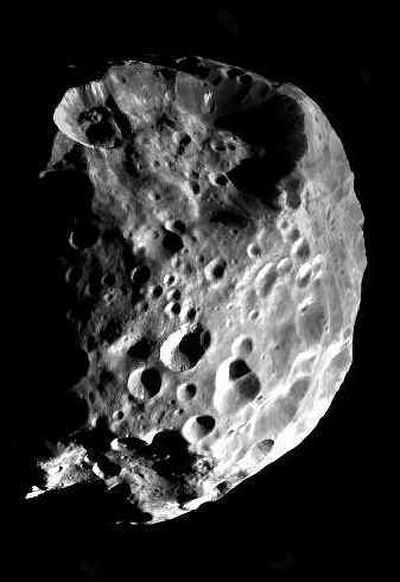Cassini spacecraft bears down on Saturn after seven-year journey

LOS ANGELES — Out so far in space that the sun is a tiny dot, the most sophisticated science spacecraft ever is nearing Saturn to begin a lengthy study of the ringed planet and its 31 known moons.
Nearly seven years after it left Earth, Cassini, an internationally built craft named for an early day astronomer, is on schedule to enter orbit June 30 after it dashes through a gap in Saturn’s shimmering rings. Scientists hope its findings will reveal new secrets about the evolution of our solar system.
Cassini had its first encounter with the Saturn system Friday afternoon, hurtling within 1,240 miles of the outermost moon, Phoebe. The tiny moon is just 137 miles across. Saturn, in contrast, is nearly 75,000 miles in diameter.
Scientists believe Phoebe originated in the outer reaches of the solar system and that it was later flung toward Saturn, which captured it into orbit.
“If it is, this will be our first encounter with something from that far out in the solar system,” said Carolyn Porco, one of the scientists on the project.
“The study of the outer planets is of great importance to us because of what they represent: Saturn, its ring system, its moons, are a miniature model of a disk of gas and dust that surrounded the early sun as the planets formed in the solar system,” Orlando Figueroa, director of NASA’s Solar System Exploration Division, said in a recent briefing.
Saturn is the sixth planet from the sun, between bigger Jupiter and smaller Uranus. It was previously visited in flybys by NASA’s Pioneer 11 on Sept. 1, 1979, Voyager 1 on Nov. 12, 1980, and Voyager 2 on Aug. 25, 1981. But none of those entered orbit around Saturn.
The $3.3 billion, U.S.-European spacecraft, which also carries a probe to explore the moon Titan, was launched in October 1997. NASA built the plutonium-powered spacecraft; the European Space Agency contributed the Huygens (pronounced Hoy’-genz) probe.